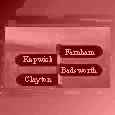


 |
 |
 |
Cameron (1988) explains that there are two main types of place-name, one being topographical and the other habitative. The first relates to the description of the features, either artificial or natural, of a locality. The second refers to places of habitation such as farms, homesteads, villages, etc. Cameron also refers to a third but smaller class, of Old English origin, which concerns settlement of a specific tribe or group. Ripon (NR), indicating the "hill of the Hrype", exemplifies such a case. More frequently, however, locations were named for a family or an individual.
Cameron (1988) expands the theme further by explaining that place-names are made up of elements. These can be either simplex, consisting of one word, or compound being made up of two words or more. The latter type may also consist of hybrids where the elements involved are derived from more than one language. The following table contains some examples of the different types found in Yorkshire. The abbreviations OE, ON, OD and Br, refer respectively to Old English, Old Norse, Old Danish and British. The presence of an asterisk before a word (e.g. *penno) is indicative of a postulated or constructed form.
| Form | Modern name | Etymology | Source |
| Simplex | Brough (NER) | OE burh "fortified place" | Cameron (1988) |
| Barugh (NWR) | OE beorg "natural mound / hill" (also "burial place") | Cameron (1988) | |
| Lund (NR) | ON lundr "small wood / grove" | Metcalfe (1992 | |
| Wass (NR) | ON vaš "ford" | Thurlow (1979) | |
| Compound | Brigham (ER) | OE brig "bridge" + ham "homestead", i.e. "homestead near the bridge" | Cameron (1988) |
| Easington (NER) | OE Esa (personal name) + ing "associated with" + tun "farmstead", i.e. "the farmstead associated with Esa" | Cameron (1988) | |
| Burnby (ER) | ON burna "stream / spring" + by "farmstead / village" | Cameron (1988) | |
| Hybrid | Coneythorp (WR) | ON kunungr "king" + OD žorp "secondary settlement / farm", i.e."the king's outlying farm" | Thurlow (1979) |
| Hindlethwaite (NR) | OE or ON hind "hind" + OE leah "forest / wood / glade" + ON žveit "meadow / clearing", i.e. "the forest clearing for hinds" | Metcalfe (1992) | |
| Bruntscar (WR) | OE brende "burnt" + ON sker "hillside" | Metcalfe (1992) | |
| Penhill (NR) | Br *penno "hill" + OE hyll "hill"† |
† Also known as a tautological compound with both elements having the same meaning.
The Grimston hybrid
Another form of hybrid not mentioned above is the Grimston hybrid. The category is thus named, says Cameron (1996), because the largest single group of place-names within it refer to locations bearing the name Grimston "Grim's village / estate". Place-names of this type consist of a Viking personal name plus the Old English tun "farmstead" and are exemplified by such as: Wiggington, (near York) from Vikingr; Catton-on-Swale (NR) from Kati; and Nawton (NR) from Nagli.
Sources
Cameron, K. (1988, 1996) English Place-Names, London: B.T. Batsford Ltd.
Metcalfe, P. (1992) Place-Names of the Yorkshire Dales, Otley, West Yorkshire: Smith Settle.
Thurlow, W. (1979) Yorkshire Place-Names, Clapham, North Yorkshire: The Dalesman Publishing Co.Ltd.